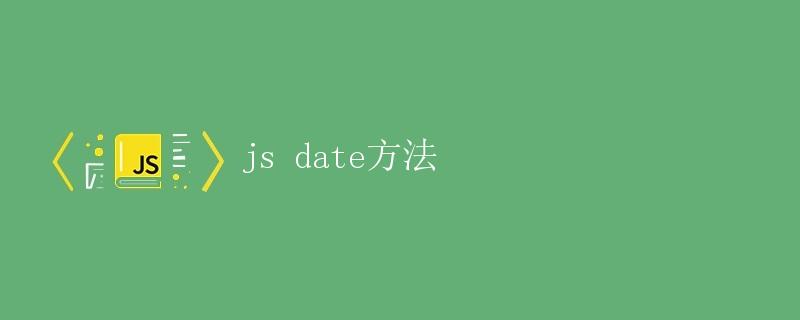JS Date方法

介绍
在JavaScript中,Date对象是用于处理日期和时间的内建对象。它提供了一系列方法和属性,用于获取、设置和操作日期和时间。
创建Date对象
要创建一个Date对象,可以使用new Date()构造函数,可以使用以下方式:
// 创建一个表示当前日期和时间的Date对象
const currentDate = new Date();
// 创建一个表示特定日期和时间的Date对象
const specificDate = new Date("2022-01-01T00:00:00");
在上面的示例中,currentDate将被赋值为当前日期和时间,而specificDate将被赋值为指定的日期和时间(2022年1月1日零点零分零秒)。
获取日期和时间信息
一旦创建了Date对象,就可以使用其方法和属性获取特定的日期和时间信息。
获取年份
要获取日期中的年份,可以使用getFullYear()方法:
const year = currentDate.getFullYear();
console.log(year); // 输出当前年份
获取月份
要获取日期中的月份,可以使用getMonth()方法。需要注意的是,getMonth()返回的月份是从0开始计数的,即0表示一月,11表示十二月。
const month = currentDate.getMonth();
console.log(month); // 输出当前月份(0到11之间的整数)
如果要获取从1开始计数的月份,可以在返回值上加1。
获取日期
要获取日期中的日期,可以使用getDate()方法:
const date = currentDate.getDate();
console.log(date); // 输出当前日期(1到31之间的整数)
获取小时
要获取时间中的小时,可以使用getHours()方法:
const hours = currentDate.getHours();
console.log(hours); // 输出当前小时(0到23之间的整数)
获取分钟
要获取时间中的分钟,可以使用getMinutes()方法:
const minutes = currentDate.getMinutes();
console.log(minutes); // 输出当前分钟(0到59之间的整数)
获取秒钟
要获取时间中的秒钟,可以使用getSeconds()方法:
const seconds = currentDate.getSeconds();
console.log(seconds); // 输出当前秒钟(0到59之间的整数)
获取毫秒数
要获取时间中的毫秒数,可以使用getMilliseconds()方法:
const milliseconds = currentDate.getMilliseconds();
console.log(milliseconds); // 输出当前毫秒数(0到999之间的整数)
获取星期几
要获取日期中的星期几,可以使用getDay()方法。需要注意的是,getDay()返回的是星期几所对应的整数值,0表示星期日,1表示星期一,依此类推。
const day = currentDate.getDay();
console.log(day); // 输出当前星期几(0到6之间的整数)
获取时间戳
时间戳表示从1970年1月1日 00:00:00 UTC(协调世界时)到当前日期和时间的毫秒数。要获取时间戳,可以使用getTime()方法:
const timestamp = currentDate.getTime();
console.log(timestamp); // 输出当前时间戳
设置日期和时间
除了获取日期和时间之外,Date对象还允许设置特定的日期和时间。
设置年份
要设置日期中的年份,可以使用setFullYear()方法:
currentDate.setFullYear(2023);
console.log(currentDate.getFullYear()); // 输出设置后的年份
设置月份
要设置日期中的月份,可以使用setMonth()方法。需要注意的是,setMonth()接收的月份是从0开始计数的,即0表示一月,11表示十二月。
currentDate.setMonth(11);
console.log(currentDate.getMonth()); // 输出设置后的月份
设置日期
要设置日期中的日期,可以使用setDate()方法:
currentDate.setDate(31);
console.log(currentDate.getDate()); // 输出设置后的日期
设置小时
要设置时间中的小时,可以使用setHours()方法:
currentDate.setHours(23);
console.log(currentDate.getHours()); // 输出设置后的小时
设置分钟
要设置时间中的分钟,可以使用setMinutes()方法:
currentDate.setMinutes(59);
console.log(currentDate.getMinutes()); // 输出设置后的分钟
设置秒钟
要设置时间中的秒钟,可以使用setSeconds()方法:
currentDate.setSeconds(59);
console.log(currentDate.getSeconds()); // 输出设置后的秒钟
设置毫秒数
要设置时间中的毫秒数,可以使用setMilliseconds()方法:
currentDate.setMilliseconds(999);
console.log(currentDate.getMilliseconds()); // 输出设置后的毫秒数
格式化日期和时间
JS中的Date对象提供了几种方法来格式化日期和时间。
格式化为字符串
要将Date对象格式化为字符串,可以使用toDateString()、toISOString()、toGMTString()、toLocaleDateString()等方法。这些方法可以根据需要返回不同的日期字符串表示。
const dateString = currentDate.toDateString();
console.log(dateString); // 输出当前日期的字符串表示
const isoString = currentDate.toISOString();
console.log(isoString); // 输出当前日期的 ISO 8601 扩展格式字符串表示
const gmtString = currentDate.toGMTString();
console.log(gmtString); // 输出当前日期的 GMT 字符串表示
const localeDateString = currentDate.toLocaleDateString();
console.log(localeDateString); // 输出当前日期的编码环境的日期字符串表示
格式化为时间字符串
要将Date对象格式化为时间字符串,可以使用toTimeString()、toISOString()、toGMTString()、toLocaleTimeString()等方法。这些方法可以根据需要返回不同的时间字符串表示。
const timeString = currentDate.toTimeString();
console.log(timeString); // 输出当前时间的字符串表示
const isoString = currentDate.toISOString();
console.log(isoString); // 输出当前时间的 ISO 8601 扩展格式字符串表示
const gmtString = currentDate.toGMTString();
console.log(gmtString); // 输出当前时间的 GMT 字符串表示
const localeTimeString = currentDate.toLocaleTimeString();
console.log(localeTimeString); // 输出当前时间的编码环境的时间字符串表示
格式化为日期时间字符串
要将Date对象格式化为日期时间字符串,可以使用toLocaleString()和toLocaleDateString()方法。这些方法可以在返回字符之前,将日期和时间格式化为指定地区的日期和时间字符串表示。
const localeString = currentDate.toLocaleString();
console.log(localeString); // 输出当前日期和时间的编码环境的日期时间字符串表示
const localeDateString = currentDate.toLocaleDateString();
console.log(localeDateString); // 输出当前日期的编码环境的日期字符串表示
时间运算
Date对象还提供了一些方法来进行时间运算,例如增加或减少年、月、日、小时、分钟、秒等。
增加或减少年份
要增加或减少日期中的年份,可以使用setFullYear()和getFullYear()方法:
currentDate.setFullYear(currentDate.getFullYear() + 1);
console.log(currentDate.getFullYear()); // 输出当前年份加1后的值
增加或减少月份
要增加或减少日期中的月份,可以使用setMonth()和getMonth()方法:
currentDate.setMonth(currentDate.getMonth() + 1);
console.log(currentDate.getMonth()); // 输出当前月份加1后的值
增加或减少日期
要增加或减少日期中的日期,可以使用setDate()和getDate()方法:
currentDate.setDate(currentDate.getDate() + 1);
console.log(currentDate.getDate()); // 输出当前日期加1后的值
增加或减少小时
要增加或减少时间中的小时,可以使用setHours()和getHours()方法:
currentDate.setHours(currentDate.getHours() + 1);
console.log(currentDate.getHours()); // 输出当前小时加1后的值
增加或减少分钟
要增加或减少时间中的分钟,可以使用setMinutes()和getMinutes()方法:
currentDate.setMinutes(currentDate.getMinutes() + 1);
console.log(currentDate.getMinutes()); // 输出当前分钟加1后的值
增加或减少秒钟
要增加或减少时间中的秒钟,可以使用setSeconds()和getSeconds()方法:
currentDate.setSeconds(currentDate.getSeconds() + 1);
console.log(currentDate.getSeconds()); // 输出当前秒钟加1后的值
增加或减少毫秒数
要增加或减少时间中的毫秒数,可以使用setMilliseconds()和getMilliseconds()方法:
currentDate.setMilliseconds(currentDate.getMilliseconds() + 1);
console.log(currentDate.getMilliseconds()); // 输出当前毫秒数加1后的值
比较日期和时间
Date对象还提供了一些方法来比较两个日期或时间的先后关系。
比较日期
要比较两个日期的先后关系,可以使用getTime()方法获取时间戳,然后进行比较。
const date1 = new Date("2022-01-01");
const date2 = new Date("2023-01-01");
if (date1.getTime() < date2.getTime()) {
console.log("date1 在 date2 之前");
} else if (date1.getTime() > date2.getTime()) {
console.log("date1 在 date2 之后");
} else {
console.log("date1 和 date2 相同");
}
比较时间
要比较两个时间的先后关系,可以比较小时、分钟、秒钟和毫秒数。
const time1 = new Date();
const time2 = new Date();
time2.setHours(time2.getHours() + 1);
if (time1.getHours() < time2.getHours()) {
console.log("time1 在 time2 之前");
} else if (time1.getHours() > time2.getHours()) {
console.log("time1 在 time2 之后");
} else {
console.log("time1 和 time2 相同");
}
总结
Date对象是JavaScript内建的日期和时间处理对象,它提供了一系列方法和属性,用于获取、设置和操作日期和时间。通过使用Date对象,我们可以方便地获取当前日期和时间,以及对日期和时间进行各种操作,如增加或减少年、月、日、小时、分钟、秒等。同时,我们还可以将Date对象格式化为不同的日期时间字符串,用于显示和处理。另外,通过比较日期和时间,我们可以判断它们的先后关系。在实际开发中,掌握Date对象的使用方法对于处理日期和时间操作非常重要。
 极客笔记
极客笔记